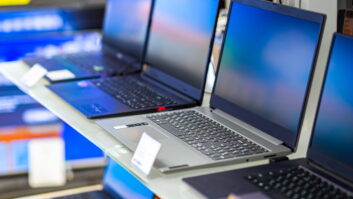An unprecedented stampede is on in the cordless phone market, as supplier rush to transition their model lines almost exclusively to DECT 6.0.
In 2009, the majority of cordless phones will be DECT-based, with some analog 5.8GHz and 2.4GHz to capture opening price points, predicted Matt Ramage, product management senior VP, VTech.
“We’re seeing many retailers move to a 100 percent DECT assortment. It has definitely exceeded our expectations,” he said.
“DECT is the world’s platform, so it has made sense, from a cost perspective, to switch,” said Brendan Morris, CEO, Uniden.
In 2009, all of Panasonic’s cordless phones will use DECT, the fastest technology transition in recent memory, said Bill Taylor, communications group VP, Panasonic.
According to The NPD Group’s retail tracking service, DECT phones jumped from close to 10 percent of the market in 2007 to 36 percent through October 2008. In dollar sales, DECT phones crossed the 50 percent share threshold during the summer.
The rapid takeover of DECT has left manufacturers without the reliable frequency step-up traditionally used to create a good, better, best assortment, Ramage said.
Instead, as in the DECT-dominated European market, competition will focus on designing within DECT — pushing features, form factors and handset bundles.
Philips, which is trying to duplicate its European success in North American retail markets, is using style and an appeal to women to help establish a broader retail footing, said Zdenek Kratky, customer marketing director, Philips.
Since its entry into the U.S. market, the company has gleaned three key insights, Kratky said. “People buy phones at the shelf, they like to buy what they’re familiar with, and they’re open to a design that is more appealing.”
Yet with prices on DECT phones falling, consumers may be unwilling to pay more for forward-looking features. Many manufacturers have made passes at more technologically robust feature sets without much success, Morris observed. “People are in the market for a phone, not a picture frame.”
Instead, selling prices are being propped up with accessory handset bundles. Yet prices there have softened as well as more handsets are crammed in, Ramage said.
The rapid success of DECT notwithstanding, the cordless category as a whole took a pounding in 2008. At the start of the fourth quarter, it had dropped 20 percent in unit sales vs. the same period in 2007, and 17 percent in dollars, according to the NPD’s retail tracking service. Most manufacturers see the market leveling over the next few years as it transitions more fully to DECT.
Manufacturers are also hoping that retailers don’t contract shelf space formerly allotted to Thomson and its GE-branded phones. Motorola, another market participant, dropped out in late 2007.
The market’s decline is due in part to changing consumer lifestyles and the lack of a viable step-up technology, suppliers said.
“People’s lives are changing” and many are content to live without a landline phone, Morris observed.
Roughly 17 percent or some 20 million U.S. households were wireless-only, according to a September survey by the Nielson Company.
“As wireless network quality improves and unlimited calling becomes increasingly pervasive, we expect the trend toward wireless substitution to continue,” said Alison LeBreton, client services VP, Nielsen Mobile. “In a tightening economy every dollar counts, and consumers are more and more comfortable with the idea of ditching their landline connection.”
Still, 10 percent of households have dabbled with cord cutting only to switch back, Nielson noted. “There are a lot of people that just feel comfortable with a home phone,” whether through cable companies or the Bells, Ramage observed.
Phone makers are also trying to capture mobile users with Bluetooth-enabled products. Panasonic, for instance, will introduce a two handset version of its Link to Cell DECT cordless product at the show.
“We may see more fixed mobile products,” said Ross Rubin, industry analysis director, NPD. “There is a greater addressable market for products that let you use your cellular minutes.”
“I think Bluetooth has a lot of promise,” Ramage said.
Even if no immediate successor to DECT is imminent, DECT technology is itself evolving into CAT-iq. The technology is geared toward IP telephony and would permit Internet-connected DECT phones to stream content and higher quality audio calls to headsets. According to the DECT Forum, roughly 65 million CAT-iq-enabled gateways and 115 million handsets will be installed worldwide by 2012.













